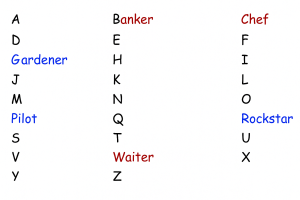The A to Z game is a fast-paced vocabulary activity that gets students thinking, moving, and often shouting (in a good way). It’s a fantastic classroom warmer, great for reviewing vocabulary or introducing new topics. You can use it with just about any theme — from jobs to adjectives, food, or things you take on holiday.
It works with most levels and class sizes and requires zero prep beyond a board and some energy.
Want more like this? Check out the big list of no-prep ESL warm-up activities
For online classes try out these picture quizzes
How to Play the A to Z Game
1. Set up the board
Write the letters A to Z in a column down one side of the board. Leave enough space next to each letter for teams to write one word.
Tip: I usually skip X unless I have very advanced students.

2. Divide the class
Split the class into two teams (three works too, but can get a bit chaotic). Each team chooses a writer who comes to the board and stands ready with a marker or piece of chalk. Make sure each team uses a different colour so you can easily see who wrote what.
3. Choose a theme
Pick a vocabulary category to focus on. Popular themes include:
- Adjectives
- Jobs
- Food and drink
- Animals
- Countries
- School objects
- Holiday items
You can also let students suggest topics or make it random using flashcards or a spinner.
4. Let the race begin
When you say “Go!”, teammates shout out suggestions for each letter. The writers race to write an appropriate word next to as many letters as they can. Only one team can claim each letter — whoever writes first gets it.
Encourage students to help with spelling and shout out ideas. I don’t mind if they use dictionaries, textbooks, or even phones — it’s all part of the fun and language discovery.
Scoring the A to Z Game
When time’s up (after 5–10 minutes or once the board is mostly filled), go through each letter. Give 1 point per correctly spelled and appropriate word
Use mistakes as learning opportunities — ask the class to correct any errors together.
Celebrate the winning team, then swap out the writers and play again with a new topic if you’ve got time.

Awesome thanks a lot❤️
I used this game but I choose few letters in order to make it more competitive and it worked perfectly! Thanks!
As a variation with a small group I used this to finish a lesson. Students stand up. Each in turn chooses a letter for eg a job if that is the theme. If anyone can’t do it they sit down. Last person standing “wins”..
THANKYOU AND I MISS YOU
This is a good way of motivating mostly in out ESL classrooms. I’m very happy to get informés about it. Thanks a lot.